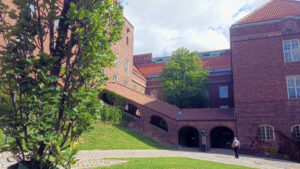 Working in science is awesome but sometimes, often at a party, it can be challenging to explain what it is that I do. I studied psychology and now work with, you know… “robots but social ones” as someone put it. Roughly two groups of people ask about my work and job, 1) those who are very interested in novel technology and psychology and 2) those who are scared this new technology is dangerous and “might steal their job”… or worse. I love talking about my job so always 1) explain as much as people find interesting and 2) reassure that robotic overlords might not happen soon (and that they probably will have an off-switch). In this post, you can read what I might say if you ask me at a party “so you work with robots, right…?”
Working in science is awesome but sometimes, often at a party, it can be challenging to explain what it is that I do. I studied psychology and now work with, you know… “robots but social ones” as someone put it. Roughly two groups of people ask about my work and job, 1) those who are very interested in novel technology and psychology and 2) those who are scared this new technology is dangerous and “might steal their job”… or worse. I love talking about my job so always 1) explain as much as people find interesting and 2) reassure that robotic overlords might not happen soon (and that they probably will have an off-switch). In this post, you can read what I might say if you ask me at a party “so you work with robots, right…?”
Author: Dr. Merijn

The Polytechnic University of Valencia hosted the people behind the Council of Coaches project working hard to create a multi-agent system, from the 5th till the 10th of March. Besides making massive steps on the technical implementation of the demonstrator, we had fun and good food!
Council of Coaches – A new project
A new year is approaching and a new project appears, Council of Coaches! In this European Horizon 2020 Project, we will look at virtual coaching. We will create an autonomous council of multiple virtual coaches that can assist people in achieving their health goals. These coaches will discuss the health situation of the user with each other and the user. In this way, we hope to be able to positively influence the lifestyle of the user in a fun and natural manner.
new year is approaching and a new project appears, Council of Coaches! In this European Horizon 2020 Project, we will look at virtual coaching. We will create an autonomous council of multiple virtual coaches that can assist people in achieving their health goals. These coaches will discuss the health situation of the user with each other and the user. In this way, we hope to be able to positively influence the lifestyle of the user in a fun and natural manner.

The 17th International Conference on Intelligent Virtual Agents (IVA 2017) was held on August 27-30 in Stockholm and I was there! The conference was organized by Kungliga Tekniska Högskolan (better known as KTH). I was involved in three publications!
 On the first day, we were located in the beautiful campus of KTH, very Harry Potter-ish. There were several workshops on this day. I attended the workshop on Interaction with Agents and Robots: Different Embodiments, Common Challenges. In a break-out session, we had a very interesting discussion about the future of evaluating social agents.
On the first day, we were located in the beautiful campus of KTH, very Harry Potter-ish. There were several workshops on this day. I attended the workshop on Interaction with Agents and Robots: Different Embodiments, Common Challenges. In a break-out session, we had a very interesting discussion about the future of evaluating social agents.
Sadly, I had to miss the Monday for family reasons. This meant I missed the awesome demo that Jan and I prepared. We showcased our ASAP Realiser – Unity3D bridge by showing how we could send a BML to ASAP, which in turn controlled the behaviour of a virtual agent in Unity. Since Unity supports many devices it is relatively easy to make it run on any device. In our case, the virtual agent was running on a Hololens (an augmented reality device). See for more information our demo paper.
 On Tuesday I was back. Just in time to cheer for Jan who presented our poster for the ASAP – Unity bridge. On this poster, and with the explanations, we tried to describe more of the technical details behind the integration, see also the poster paper. The picture is proof of the high interest from the IVA community for our work and for Jan’s awesome enthusiasm. Thanks, Jan!
On Tuesday I was back. Just in time to cheer for Jan who presented our poster for the ASAP – Unity bridge. On this poster, and with the explanations, we tried to describe more of the technical details behind the integration, see also the poster paper. The picture is proof of the high interest from the IVA community for our work and for Jan’s awesome enthusiasm. Thanks, Jan!
 Wednesday was the last day of the conference and on this day Angelo presented our work titled Selecting and Expressing Communicative Functions in a SAIBA-Compliant Agent Framework. Please take a look at the IVA short paper for more information.
Wednesday was the last day of the conference and on this day Angelo presented our work titled Selecting and Expressing Communicative Functions in a SAIBA-Compliant Agent Framework. Please take a look at the IVA short paper for more information.
It was really nice to again see ‘the people of IVA’. I really enjoyed the discussions and am looking forward to the next IVA, which is in…. Sidney! Wow, talk about motivation! I am going to submit some nice work and really hope that I’ll be allowed to go there.
–
After the conference, Manon came over and we had a couple of nice couple-days in Stockholm!



I gave a talk about the virtual suspect at the Deep Learning Summit Chatbots track in London this 23rd of September.
Police Interview Training with Virtual Suspects @merijnman #reworkbots #reworkDL pic.twitter.com/byixAeLKBA
— Diane (@reworkdiane) September 23, 2016
The event was expertly organised by RE.WORK and the crowd was great. I had very pleasant discussions afterwards with, for example, Sylvain and Lewis. People even tweeted about my talk, very nice.
Virtual Suspects: not tying to convince that bot is human BUT needs to allow suspension of disbelief @merijnman #reworkbots @teamrework
— Mark Wood (@DoctorRobotnik) September 23, 2016
Full Paper Accepted at ACE
Our paper titled “A Moving Feast: Effects of Color, Shape and Animation on Taste Associations and Taste Perceptions” has been accepted as a full paper at the Advances in Computer Entertainment 2016 (ACE2016) conference. In the paper, you can read about the influence of visual stimuli on taste associations and taste experiences. We describe an experiment where participants tasted several samples of yoghurt which were presented with projections around them, thus changing their appearance.
Upcoming Talk
I will give an invited talk at the Chatbots Track at the Deep Learning Summit London, on 22 September 2016.
AI & deep learning are powering interactive messaging services known as chatbots & virtual assistants, which use conversational interfaces to create deeper, more personalised one-to-one customer experiences. The Chatbot Track will explore the technical advancements in deep learning, NLP & predictive intelligence to create conversational self-learning bots for messaging platforms, healthcare, personalised services & more.
My talk will be titled: Believable Virtual Suspects – Virtual Humans that Role-Play as a Suspect in a Practise Police Interview
A virtual character that behaves as a human can be used to train people in social interactions. For example, a virtual agent that plays the role of a suspect in practice police interviews can be used by students of the police academy to hone their interrogation skills. Creating a virtual character that behaves as a human is a challenge we approach by looking at how humans behave in this situation. We find psychological concepts and theories that explain the behaviour of humans and use these to create a behaviour selection model for the virtual character. The result is a virtual character, a virtual suspect, that behaves in a believable and (anti)social manner.
ICT.OPEN 2016
ICT.OPEN is a conference for Dutch ICT researchers. Three projects that I am involved in were present at ICT.OPEN2016. I was pleasantly surprised to meet many people who shared my enthusiasm for socially intelligent computing.
I am co-organizing a workshop about using Virtual Agents for social skills training. The call for papers:
Virtual Agents for Social Skills Training (VASST) Workshop @ INTETAIN 2016
The VASST workshop at the INTETAIN 2016 conference aims to give an overview of recent developments of interactive virtual agent applications that are intended for training the social skills of the user. Here a virtual agent takes the role of a training actor in a role-playing exercise enabling the user to practice his or her social skills. This technology requires thorough knowledge from multiple research domains, e.g., (serious) game mechanics, human factors, (social) signal processing, user-specific feedback mechanisms, and artificial intelligence. When successfully combined, these novel interaction paradigms can impact the serious gaming industry.
We welcome small, innovative, unpublished research describing the state-of-the-art for all factors relevant to interaction with VASST, such as literature studies, user studies, design concepts and position papers.
3, 2, 1… Live
It turns out I do a lot of things. Starting in time with a blog is not one of them, but hey, better late than never. So here we go, a website about the stuff that I, Merijn Bruijnes, do as an aspiring scientist and find interesting as a general enthusiast. Nice to meet you.
